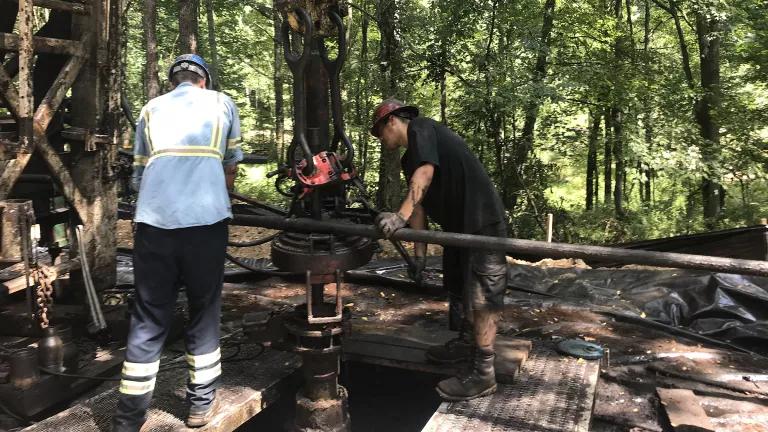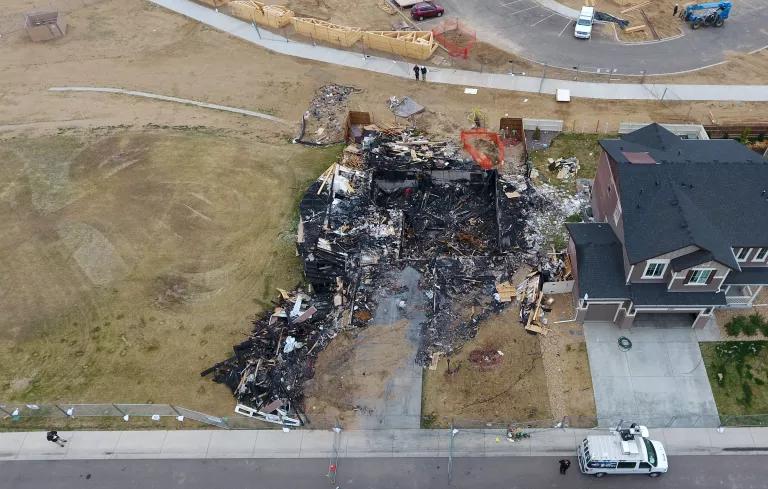Ohio Gains Ground on a Hidden Hazard: More Than a Century’s Worth of Abandoned Oil and Gas Wells
Forgotten, derelict, and often leaky, these so-called orphan wells could number in the thousands.

A crew plugging an abandoned well in Ohio
Courtesy Brittany Patterson/Ohio Valley ReSource
Having the smell of rotten eggs permeate the halls and classrooms of your school is pretty gross, but when you have to evacuate because the building is filling with methane, a flammable gas, it’s downright scary. That’s what happened in 2014 to the 375 students and teachers of Admiral King Elementary School in northeastern Ohio. After five long weeks searching for the source of the gas, the Ohio Department of Natural Resources (ODNR) discovered it in a strange place: under the gym. An old oil and gas well that nobody knew was there had begun to leak. Three months and more than $100,000 later, the students were able to safely return to school.
The school’s students and faculty were lucky. In 2017, a similar methane buildup, this one caused by an abandoned and subsequently severed gas line connected to an oil and gas well, caused an explosion in a Colorado home that killed a man and his brother-in-law, both 42, and seriously injured his wife.
In addition to being serious explosion hazards, abandoned fossil fuel wells can contaminate groundwater with oil and other toxic chemicals, such as lead and arsenic. Steve Irwin, ODNR spokesman and contract manager for the agency’s abandoned well program, says, “We feel very strongly that, if unaddressed, orphan wells pose a threat to citizens and the environment.”
ODNR has plugged more than 2,000 so-called orphan wells since the 1970s, but at least 737 remain. Ohio had 50,000 oil and gas wells in production in 2017, but since the 1860s, when Ohio drilled its first oil well, some 275,000 have followed. Potentially, tens of thousands more could be out there that we don’t know about.
The state legislature came together to do something about it last fall by passing the Orphan Well Bill in a rare unanimous vote (92 to 0). The new law doubles the budget for the state’s orphan well program, funded by a severance tax collected from oil and gas companies. In December, the state legislature announced a goal of capping 173 orphan wells in the 2019 fiscal year. That’s a huge step up from the 83 it capped last year. (In 2015, it capped just 16.)

A gas well covered by tan fencing (upper left) is less than 200 feet from a home in Firestone, Colorado, where a fatal explosion occurred on April 27, 2017.
ODNR says the additional funds allow it to more adequately staff its program and pay for well capping, which can get pricey—anything from a few grand to $200,000. Irwin says one of the biggest challenges of plugging wells is overcoming all their surprises. The first priority is containment. The well operator (or, if orphaned, a hired contractor) works with an ODNR inspector to make sure the well’s oil and gas aren’t migrating into groundwater or elsewhere. This gets tricky in the case of orphan wells because there’s often no information on what type of casing the drillers used or the well’s depth. It’s also common to find obstructions, such as rocks, buckets, tree stumps, cannonballs, and other strange objects that have fallen or been thrown into the well.
Andy Thompson, a former state representative who reached his term limit last year, calls the legislation, which he sponsored, a public relations winner because it makes a variety of interest groups—including the Ohio Oil and Gas Association and the Ohio Environmental Council—look good. (A fan of puns, he refers to it as the “Get Wells Soon” bill.) It takes tax proceeds from oil and gas companies’ continued drilling to clean up “legacy issues” that can damage their public image. The severance tax is low, compared with those in surrounding states, but devoting 30 percent of it to plugging orphan wells is a big improvement.
For Thompson, the push to plug these dangerous sites is personal. While 62 percent of Ohio’s counties are known to have orphan wells, Thompson’s former constituents in southeastern Ohio, including Carroll, Harrison, and Noble Counties, have many on their land, along with the majority of new drilling. (Almost one-sixth of known orphan wells are concentrated in two counties in northwest Ohio.) Even Thompson’s brother Bill has found abandoned wells on his farm.
The delinquent wells aren’t just relics from the 19th century. The region’s fracking boom, which began around the turn of this century, has added its share of orphans into the mix—especially during the 2008 financial crisis and the 2014 economic downturn, which led to crashes in the energy market. Such busts can also shrink the amount of tax money coming in from drillers to plug wells.
Currently, though, there’s a lot of cash coming in from the severance tax. “Since production has been so vibrant in eastern Ohio,” says Irwin, referring to a boom in Ohio’s Utica Shale natural gas industry, “the severance tax money has increased.” He estimates that in 2019, that number will come in at around $12 million.
An important consideration, says NRDC energy expert Amy Mall, is making sure an orphan well program “holds oil and gas producers accountable for cleaning up their dangerous messes.” When wells are permitted, she says, the government should ensure there will be money to clean up and properly plug them afterward. Current oil and gas well owners in Ohio pay a surety bond ($5,000 per well or $15,000 per multi-well project), which helps cap their wells after completion, but Mall says that still isn’t enough.
Thompson hopes the success of Ohio’s enhanced orphan well program will ripple around the region. Ohio now spends almost 10 times as much as Kentucky and West Virginia combined on capping wells, but it can set an example at the national level too. At least 75 percent of some 3.5 million oil and gas wells drilled in North America are no longer in production. Between 1988 and 2009, the Bureau of Land Management spent $3.78 million to plug wells on federal land. States are responsible for finding, funding, and plugging their own orphaned wells.
“It’s my 65th birthday tomorrow,” Thompson said in February, laughing softly. “I wonder if I’ll still be around to see them all plugged.”
This NRDC.org story is available for online republication by news media outlets or nonprofits under these conditions: The writer(s) must be credited with a byline; you must note prominently that the story was originally published by NRDC.org and link to the original; the story cannot be edited (beyond simple things such as grammar); you can’t resell the story in any form or grant republishing rights to other outlets; you can’t republish our material wholesale or automatically—you need to select stories individually; you can’t republish the photos or graphics on our site without specific permission; you should drop us a note to let us know when you’ve used one of our stories.
The Dakota Access Pipeline: What You Need to Know
A Fearless Defender for Our Future
Following Spills, Ohio Wants to Reroute the Rover Pipeline but Lacks the Muscle